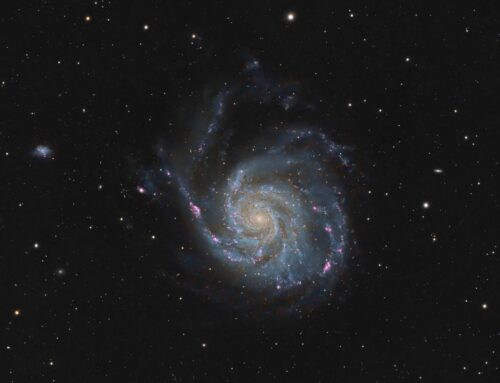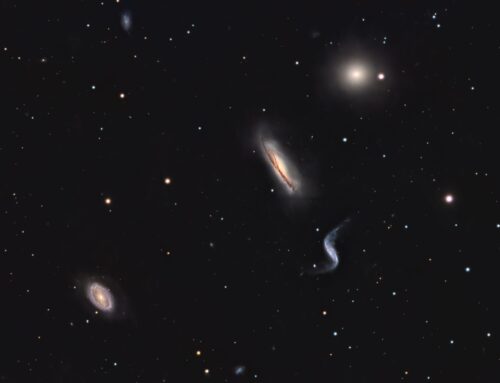NGC 4244, The Silver Needle Galaxy
 Click image for full size version
Click image for full size version
March 23, 2020
This is NGC 4244, the Silver Needle Galaxy, not to be confused with the Needle Galaxy (NGC 4565). It lies about 14 million light years from us, in Canes Venatici (the Hunting Dogs), and is part of a larger group known as the M94 group, after its brightest member. Tip to tip, NGC 4244 covers it a little more than half the Moon’s diameter. The Silver Needle shows pink nebulae, bluish knots of star formation, and a dark dust lane. I find it quite beautiful, and am a little surprised that it isn’t imaged more often by amateurs.
This is another image that was acquired using a new (for me) technique that has two setups mounted and running together. I captured the colour data with a one-shot colour camera on my Takahashi 4″ refractor, and acquired luminance data — to reveal detail — with my mono camera on my 6″ Sky-Watcher Esprit refractor. Both telescopes were mounted on a single Paramount MX mount. In this way I was able to accumulate more than 21 hours of light in just 2 nights.
Tekkies:
Acquisition, focusing, guiding and control of Paramount MX mount with TheSkyX. Focus with Optec DirectSync motor and controller. Automation with CCDCommander. Equipment control with PrimaLuce Labs Eagle 3 Pro computer. All pre-processing and processing in PixInsight. Acquired from my SkyShed in Guelph. No moon, above average transparency and average or better seeing. Data acquired March 21-23, 2020.
Luminance: Sky-Watcher Esprit 150 f/7 refractor and QHY 16200-A camera with Optolong UV/IR filter
Chrominance: Takahashi FSQ-106 ED IV @ f/3.6 and QHY367C one-shot colour camera with Optolong L-Pro filter
Chrominance: 141 x 3m = 423m
Total: 21hr13m
Data Reduction and Processing
Preprocessing: The WeightedBatchPreProcessing script was used to create a Luminance master frame (from the mono camera) and a RGB master frame (from the one-shot colour camera).
Gradient Removal: MURE Denoise script was applied to L. DBE was applied to L and RGB masters using Subtraction.
Colour
Channel Registration: To improve channel registration, the colour channels of the RGB master were extracted and aligned with StarAlignment, using Thin Plate Splines with Distortion Correction and the green channel as the reference frame. The registered colour channels were recombined with ChannelCombination.
Colour Balancing: Colour was balanced with ColorCalibration.
Linear Noise Reduction: MultiscaleLinearTransform was used to reduce noise in the background areas, using an internal mask to protect bright structures. Layer settings for threshold and strength: Layer 1: 5.0 0.85, 2 iterations; Layer 2: 3.5, 0.75, 2 iterations; Layer 3: 3.0, 0.5, 1 iteration; Layer 4: 1.0, 0.25, 1 iteration.
Stretching: HistogramTransformation was applied to make a pleasing, bright image, with background set to an intensity of approximately 0.10.
Lightness
Deconvolution: StarMask was applied with default settings to produce a Local Deringing Support Image. A clone of the image was stretched to use as a deconvolution mask. Deconvolution was applied (100 iterations, regularized Richardson-Lucy, external PSF made using PSFImage script with about 50 stars).
Linear Noise Reduction: MultiscaleLinearTransform was used to reduce noise in the background areas, using an internal mask to protect bright stars. Layer settings for threshold and strength: Layer 1: 3.0 0.85, 1 iterations; Layer 2: 2.0, 0.75, 1 iterations; Layer 3: 1.0, 0.5, 1 iteration.
Stretching: HistogramTransformation was applied to make a pleasing, bright image, with background set to an intensity of approximately 0.10.
Combining Lightness and Colour Images
Registration of L and RGB: StarAlignment was used to register the RGB master to the L master.
LRGB Combination: The lightness image was applied to the RGB image using LRGBCombination with default settings.
Additional Processing
Nonlinear Noise Reduction: TGVDenoise was used in L*a*b* mode to reduce noise with a mask used to target the background areas and protect the stars (max. 1000 iterations and convergence selected for both lightness and chrominance).
Contrast Enhancement: LocalHistogramEqualization was applied twice using a mask to isolate the core of the galaxy. First pass was Kernel Radius 50, Contrast Limit 1.5 and Amount 0.66. Second pass was Kernel Radius 150, Contrast Limit 1.5 and Amount 0.57.
Sharpening: The galaxy was sharpened with a pass of MultiscaleLinearTransform (bias +0.1 on 2nd and 3rd layers) followed by UnsharpMask (Standard Deviation of 1.0, amount 0.6, Dark Deringing 0.05)
Final Steps: Galaxy, background and star brightness, contrast, and colour saturation were adjusted in several iterations using CurvesTransformation with masks as required. ICCProfileTransformation (sRGB IEC61966-2.1; Relative Colorimetric with black point compensation) was applied prior to saving as a jpg.






Great stuff Ron….
We are currently on our way home from Florida… staying tonight in Knoxville Tenn and will be back in Guelph tomorrow night. Pat and I spent Jan and Feb in NZ and had a wonderful time there… enjoying the southern night sky… Went to florida on March 4, intending to stay for a couple of months but the microbes had other ideas…
I am glad my friend John Percival has joined your email list… I showed him a few images when we met up in NZ in Feb and he was hooked. Hope you and your family are keeping safe in these crazy times. Once this has all blown over, I still want to come out and see you at your skyshed sometime…. perhaps another 6 month or so! Keep up the great work… I love what you do… thanks…. sg.